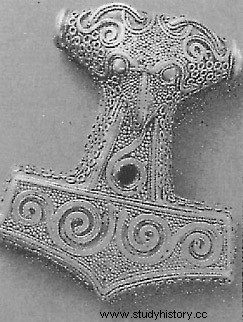"Crusher" (?), disputed etymology. Hammer of Thôrr.

It is the “hammer” of Thôrr and, this god incarnating the thunder, the (or the) lightning; it has the virtue of returning to the hand of the god, like a boomerang. According to Snorri Sturluson, Loki had it made by marvelous dwarves, but, having distracted them in their work, the handle remained too short! In the Thrymskvida (Poetic Edda), the giant Thrymr steals the hammer and will only return it to Thôrr if Freyja is given to him as his wife; to recover it, Thorr is then obliged, on Loki's insistence, to impersonate Freyja by donning a wedding veil and the Brisingar necklace. Thôrr uses him during his many fights against giants. But Mjollnir is not exclusively the instrument of the god's strength and warrior virtue. It assumes other functions, no doubt deeper and more archaic still. First, it is a guarantee of fertility. As G. Dumézil pointed out, lightning and storms being followed by regenerating rain, Thôrr thus presides over fertility. This is why we often read:"Let Thorr bless [or consecrate] these runes", "this inscription", etc., clearly reminiscent of rock carvings, where a figure wielding an ax "consecrates" a hieros gamos which unfolds under their eyes. Sweden preserved until the beginning of this century the custom of the hammarsang, which consisted of hiding a hammer in the bed of the newlyweds on their wedding night. This object with obvious magical functions appears on many supports. At the time of Christianity, it must have been used as a counterpart to the Christian cross, as evidenced by foundry molds allowing the manufacture of either a hammer or a cross. Let's add that Mjbllnir has many correspondents in the Indo-European field.
